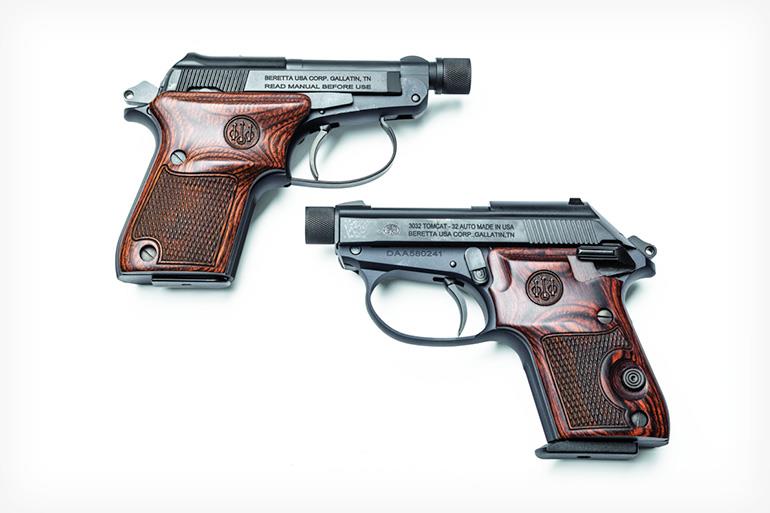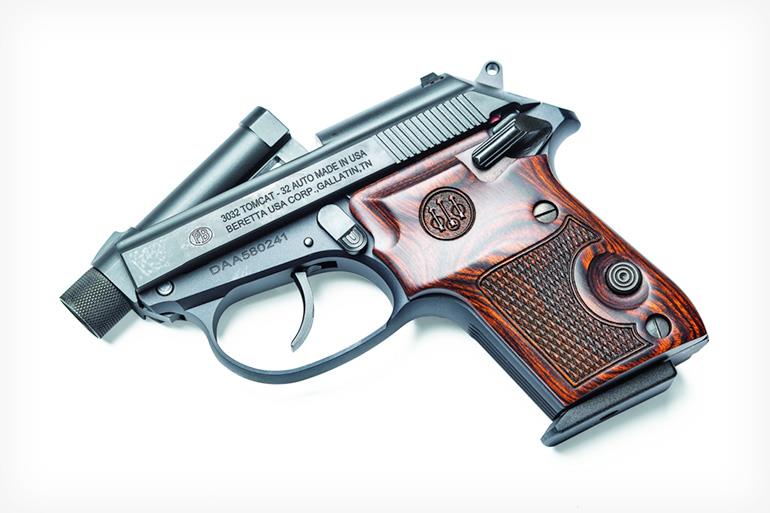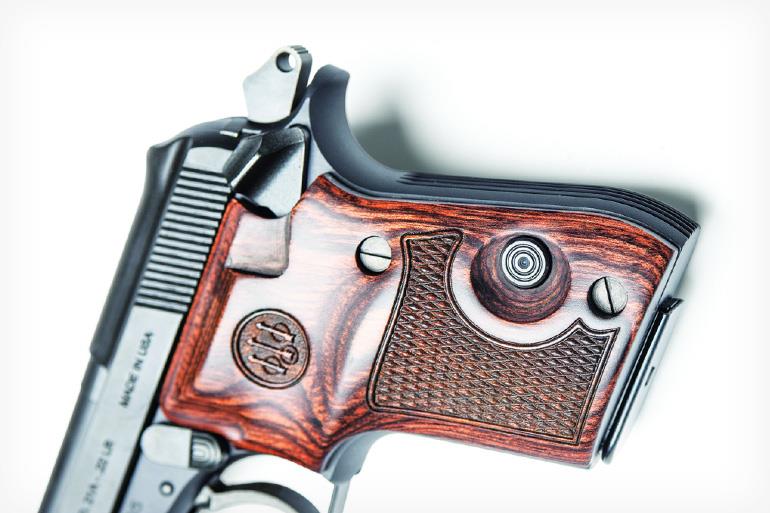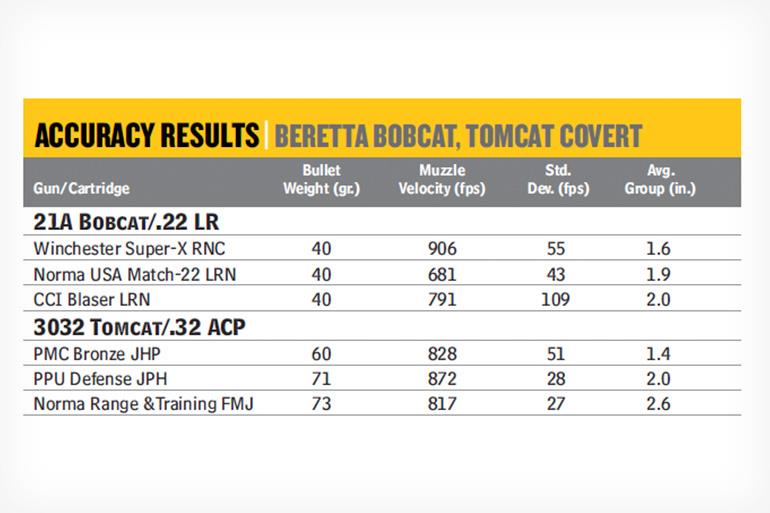Will Beretta Make the Tomcat Again
Beretta 21A Bobcat and 3032 Tomcat Pistols: Two Cool Cats
Beretta's diminutive 21A Bobcat and 3032 Tomcat converts are easy-shooting concealed-carry semiauto pistols.

(Handguns Magazine photo)
March 04, 2021
Although Beretta has existed as a company for nearly 500 years, many American handgunners were unfamiliar with the firm until the U.S. military adopted the Model 92S in 1984. The 92S, adopted as the M9, was far from the company's first effort in the semiautomatic market, though, with designs going back to 1915.
Like many European pistols, most of Beretta's creations over the years have been far more compact and concealable than the Model 92. Today, the smallest handguns in the company's catalog are the 21A Bobcat and the 3032 Tomcat. These micro-compact handguns have been market staples for years, but last year they were introduced for the first time with factory-threaded barrels. Suppressor owners and secret agents rejoice!
In 1967, Beretta introduced the Model 20, an innovative and incredibly compact handgun chambered in .25 Auto. Thanks to the Gun Control Act of 1968 and the subsequent importation ban of numerous handgun designs, the Model 20 was never widely adopted by American shooters. Still, its fundamental design offered some real appeal.

Both the 21A Bobcat Covert (top) and 3032 Tomcat Covert are highly concealable and nearly identical in size. (Handguns Magazine photo)
The Model 20 was built with an open slide and blowback operation, and its most notable feature was a tip-up barrel that allowed users to load a cartridge into the chamber without racking the slide. That might not seem like a big deal unless you are someone with diminished physical capacity or strength, and the Model 20's loading arrangement offered these people a real solution.
In order to better compete in the North American market and produce pistols for the U.S. military, Beretta built a manufacturing facility in Maryland, and Beretta USA was born. This U.S. presence exempted the company from the "sporting purpose" importation requirements and once again allowed the company to sell its compact handguns stateside.
In 1984, the company released the Model 21A. It's a handgun similar in design to the Model 20, but in addition to the .25 Auto option, it's also chambered in the more useful and available .22 Long Rifle cartridge. Like the Model 20, the blowback-operated 21A maintains the unique tip-up barrel arrangement. The tiny 21A became popular with those seeking ultimate concealment, whether as a primary or backup handgun. When nothing but the most compact handguns would do, the Model 21A was an easy answer.
That was 1984, when concealed carry wasn't as widely available to citizens as it would be a decade later, and in 1996, Beretta introduced the Model 3032 Tomcat, a slightly larger handgun chambered in the more potent .32 Auto cartridge.
Though the open slide is distinctly Beretta and may appear similar to the Model 92, these subcompacts are a different animal. Both the 21A and the 3032 are simple blowback handguns. There is no extractor on either pistol, and they rely on the blowback pressure and a fixed ejector to clear spent brass. There is also no recoil spring in the traditional sense. The slide moves rearward against two spring-loaded levers that protrude upward from the frame and return it to battery.
These guns are double action/single action, so they can be fired with the external hammers cocked or uncocked. A manual thumb safety on the left side of the frame allows for cocked-and-locked carry. This is particularly attractive for individuals who would physically struggle with the longer and heavier double-action trigger pull. There is no decocking lever on either handgun.

The unique tip-up barrel allows the tiny Berettas to be loaded and unloaded without racking the slide. (Handguns Magazine photo)
Frames are machined from aluminum alloy, and the slides are machined from cold-drawn steel. The barrels are made from steel forgings. The steel parts are finished in Beretta's own Bruniton finish, which is an epoxy applied over Parkerizing. Frames are anodized black for a perfect match. A flat dark earth version of both Covert pistols is also available, with flat dark earth Cerakote applied to the steel parts and a flat dark earth anodized frame.
Recommended
Neither pistol incorporates a slide stop, and the slide does not lock back on an empty chamber. Where the slide stop would reside on most semiautomatic handguns, we find the lever that actuates the tip-up barrel. Articulating the lever releases the barrel under spring tension and exposes the rear of the chamber.
A loaded round can be inserted into the chamber and a loaded magazine seated, allowing the user to load the gun without ever racking the slide. This also allows users to safely decock the pistols by raising the barrel and subsequently lowering the hammer.
When we think about trigger pulls, we must put these handguns in the proper context. These are defensive guns designed for close-range use. The double-action trigger pulls on these guns are long and relatively heavy: 10 pounds on the 21A and 12 pounds on the 3032. This ensures a very deliberate decision to fire the handguns and is actually listed as a safety feature in the instruction manuals of both guns.
The single-action pulls were an identical 6.25 pounds on both test samples I received. If someone lacks the hand strength for the double-action pull, carrying these pistols cocked and locked is a solution. Both double- and single-action triggers exhibited perceptible creep, but again, these aren't target guns.
Both the 3032 and 21A use single-stack magazines that have a capacity of seven rounds. The magazine release is a round steel button that is recessed into the laminated walnut grip panel on the left side of the frame. The position is such that the fastest way to release a magazine is using the thumb of the left hand. Otherwise, actuating the release requires significantly shifting the right-hand grip.
The sights on both the Bobcat and Tomcat are fixed. The plain black front sights on both pistols are machined integrally to the barrels. On the Bobcat, the rear sight is part of the slide itself, but on the slightly larger Tomcat, the rear sight is secured using a dovetail. The sights on both guns are very small and designed to be resistant to snagging.

The frame-mounted magazine release is recessed into the walnut grip panel, and the recess is such that using your non-firing hand is the best way to operate it. (Handguns Magazine photo)
Mounting a suppressor on either pistol obscures the target from the sight plane. The sights can still be used to align the handgun, but a full sight/target picture is impossible. This is a common issue with many suppressed handguns.
Both the 21A Bobcat and 3032 Tomcat were successful handguns for many years, but to many of us, something was missing. In Ian Fleming's first 007 novel, Casino Royale, the hero carries a Beretta Model 418 in .32 ACP with a silencer attached. In the theme of that earlier gun, these slick little Beretta pistols screamed "James Bond," tuxedo and all. But lacking threads with which to mount a suppressor, they couldn't complete the secret agent package. That all changed in 2020 with the release of the Covert models.
Both handguns are equipped with factory-threaded barrels designed to accept suppressors. The barrels on both handguns are threaded 1/2x28, one of the more common patterns for rimfire and centerfire handgun suppressors—like the Silencerco Switchback you see on the lead photograph for this article as well as the cover.
It goes without saying that one cannot use a suppressor designed for a .22 on a .32, even though the thread pattern is the same. Suppressors for a .32 are extremely rare in the United States, so a small 9mm suppressor is the way to go on the 3032. Knurled thread protectors cover the threads when not in use.
Because the barrels on both models are short, just under two inches, we performed our accuracy testing at 15 yards. Despite relatively heavy triggers and tiny sights, both guns were plenty accurate for their intended use. More importantly, both handguns were reliable with most ammunition tested.
Our only 21A malfunctions occurred with Norma's Match .22 ammunition, which is designed to operate at target (usually subsonic) velocity. Since the 21A is a blowback handgun, a certain power level is necessary to make the gun cycle. I was curious whether subsonic loads would work with a suppressor attached, theory being that the device would create more back pressure on the slide. Using this ammo, I function-tested the 21A with a SilencerCo Warlock II suppressor attached and found that it cycled normally. Unless you're using a suppressor, stick to high-velocity loads.
On the 3032, some of the PPU Defense Line jacketed hollowpoint rounds hung up inside the magazine, restricting the travel of the follower. This dimensional incompatibility appeared to result from the bullet's ogive dragging on the inside of the magazine and was not an issue with the other two loads we used.

Barrels are threaded 1/2x28, making them compatible with many rimfire and centerfire suppressors without the need for an adapter. (Handguns Magazine photo)
With our formal accuracy testing complete, it was time for more practical use. Concealable, yes, but shootable? One of my favorite defensive handgun targets is a half-size IPSC steel target made by MGM. The humanoid plate measures almost 15 inches high and nine inches wide, so it is less forgiving than a full-size silhouette. I ran magazine after magazine through the Bobcat and the Tomcat at distances from seven to 10 yards. I was shooting fast and never missed with either handgun. That's pretty impressive pocket pistol performance if you ask me.
Recoil was minimal with both handguns, with the 21A being ideal for the recoil-shyest among us. Though the grip sizes on both guns are identical, the slides differ in terms of width, which makes them handle slightly differently. I actually preferred shooting the 3032, probably because it's a little beefier and therefore a few ounces heavier.
Disassembly is surprisingly simple on both models. Push the barrel-release latch forward, tipping the barrel to its upward position. With the hammer cocked, retract the slide slightly. Pull upward and forward on the slide until it clears the frame rails, which allows it to be removed. The grip panels are secured using two standard slotted screws, removal of which exposes the frame underneath. No further disassembly is recommended by the manufacturer.
Carrying a full-size or even a subcompact handgun for defensive use isn't for everyone. A functional pocket gun is better than no gun at all, and these two Tennessee-built examples from Beretta are quality-built handguns.
For those with certain physical disabilities, the 21A and 3032 may be the only semiauto options on the market. For the rest of us, either handgun is a solid choice for deep concealment or as a backup pistol. The ability to mount a suppressor onto these guns puts them into the "fun gun" category, opening up their utility to an entirely different segment of the shooting public.

Notes: Accuracy results are averages of four five-shot groups fired at 15 yards from a Target Shooting Inc. Model 1500 rest. Velocities are averages of 10 shots using a LabRadar Doppler Chronograph placed adjacent to the muzzle. Abbreviations: FMJ, full metal jacket; JHP, jacketed hollowpoint; LRN, lead round nose; RNC, roundnose copper-plated (Handguns Magazine graphic)
Beretta 21A Bobcat Covert (3032 Tomcat Covert) Specs:
- Type: DA/SA semiautomatic
- Caliber: .22 LR (.32 Auto)
- Capacity: 7+1
- Barrel: 2.9 in.
- OAL/Height/Width: 4.9/3.7/1.1 in.
- Weight: 11.8 oz. (14.5 oz.)
- Construction: aluminum frame, steel slide and barrel
- Grips: laminated walnut
- Sights: integral front and rear (dovetailed rear, integral front)
- Safeties: manual thumb, inertia-type firing pin
- Trigger pull: 6.25 lb. single action; 10 lb. (12.25 lb.) double action
- Price: TBD; see website
- Manufacturer: Beretta, BerettaUSA.com
Source: https://www.handgunsmag.com/editorial/beretta-21a-bobcat-3032-tomcat-pistols/389467
0 Response to "Will Beretta Make the Tomcat Again"
Post a Comment